
The Leonard P. ZakimBunker Hill Memorial Bridge is a cable-stayed bridge completed in 2003 across the Charles River in Boston, Massachusetts. It is a replacement for the Charlestown High Bridge, an older truss bridge constructed in the 1950s.

The Battle of Bunker Hill was fought on June 17, 1775 during the Siege of Boston in the first stage of the American Revolutionary War. The battle is named after Bunker Hill in Charlestown, Massachusetts, which was peripherally involved. It was the original objective of both the colonial and British troops, though the majority of combat took place on the adjacent hill which became known as Breed's Hill.
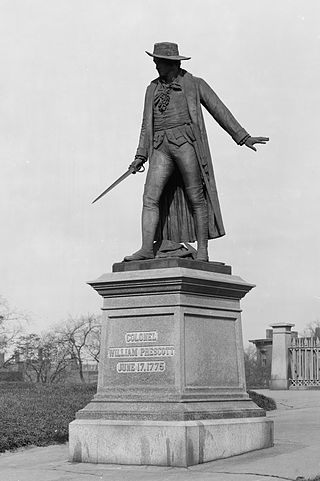
William Prescott was an American colonel in the Revolutionary War who commanded the patriot forces in the Battle of Bunker Hill. Prescott is known for his order to his soldiers, "Do not fire until you see the whites of their eyes", such that the rebel troops may shoot at the enemy at shorter ranges, and therefore more accurately and lethally, and so conserve their limited stocks of ammunition. It is debated whether Prescott or someone earlier coined this memorable saying.

Charlestown is the oldest neighborhood in Boston, Massachusetts, in the United States. Also called Mishawum by the Massachusett, it is located on a peninsula north of the Charles River, across from downtown Boston, and also adjoins the Mystic River and Boston Harbor waterways. Charlestown was laid out in 1629 by engineer Thomas Graves, one of its earliest settlers, during the reign of Charles I of England. It was originally a separate town and the first capital of the Massachusetts Bay Colony.

Joseph Warren, a Founding Father of the United States, was an American physician who was one of the most important figures in the Patriot movement in Boston during the early days of the American Revolution, eventually serving as President of the revolutionary Massachusetts Provincial Congress. Warren enlisted Paul Revere and William Dawes on April 18, 1775, to leave Boston and spread the alarm that the British garrison in Boston was setting out to raid the town of Concord and arrest rebel leaders John Hancock and Samuel Adams. Warren participated in the Battles of Lexington and Concord the following day, the opening engagements of the American Revolutionary War.
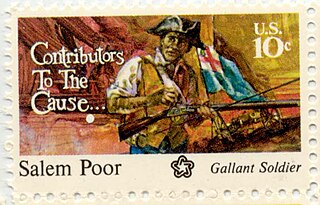
Salem Poor (1747–1802) was an enslaved African-American man who purchased his freedom in 1769, became a soldier in 1775, and rose to fame as a war hero during the American Revolutionary War, particularly in the Battle of Bunker Hill.

The Freedom Trail is a 2.5-mile-long (4.0 km) path through Boston that passes by 17 locations significant to the history of the United States, marked largely with brick. It winds from Boston Common in downtown Boston, to the Old North Church in the North End and the Bunker Hill Monument in Charlestown. Stops along the trail include simple explanatory ground markers, graveyards, notable churches and buildings, and a historic naval frigate. Most of the sites are free or suggest donations, although the Old South Meeting House, the Old State House, and the Paul Revere House charge admission. The Freedom Trail is overseen by the City of Boston's Freedom Trail Commission and is supported in part by grants from various non-profit organizations and foundations, private philanthropy, and Boston National Historical Park.

The Bunker Hill Monument is a monument erected at the site of the Battle of Bunker Hill in Boston, Massachusetts, which was among the first major battles between the Red Coats and Patriots in the American Revolutionary War. The 221-foot granite obelisk was erected between 1825 and 1843 in Charlestown, Massachusetts, with granite from nearby Quincy conveyed to the site via the purpose-built Granite Railway, followed by a trip by barge. There are 294 steps to the top.

Community College station is a rapid transit station on the MBTA Orange Line in Boston, Massachusetts. It is located in the Charlestown neighborhood off Austin Street near New Rutherford Avenue (MA-99), under the double-decked elevated structure carrying Interstate 93 to the Zakim Bunker Hill Bridge. The station is named for the adjacent Bunker Hill Community College. The station opened in April 1975, replacing the City Square and Thompson Square stations of the Charlestown Elevated. It was made accessible around 2005.

The Boston National Historical Park is an association of sites that showcase Boston's role in the American Revolution and other parts of history. It was designated a national park on October 1, 1974. Seven of the eight sites are connected by the Freedom Trail, a walking tour of downtown Boston. All eight properties are National Historic Landmarks.

Boston's diverse neighborhoods serve as a political and cultural organizing mechanism. The City of Boston's Office of Neighborhood Services has designated 23 Neighborhoods in the city:

The Most Worshipful Grand Lodge of Ancient Free and Accepted Masons of the Commonwealth of Massachusetts, commonly referred to as the Grand Lodge of Massachusetts and abbreviated GLMA, is the main governing body of Freemasonry within Massachusetts, and maintains Lodges in other jurisdictions overseas, namely Panama, Chile, the People's Republic of China, and Guantanamo Bay Naval Base, Cuba.

The Charlestown Bridge, officially named the North Washington Street Bridge, is located in Boston and spans the Charles River. As the river's easternmost crossing, the bridge connects the neighborhoods of Charlestown and the North End. Completed in 1900 and given its current official name in 1910, the bridge carries a portion of the Freedom Trail linking to the USS Constitution and Bunker Hill. To the north of the bridge, Route 99 begins and the street becomes New Rutherford Avenue.
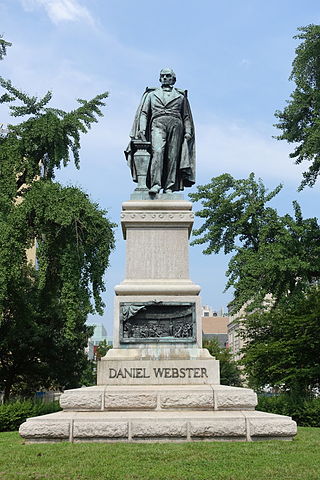
The Daniel Webster Memorial is a monument in Washington, D.C. honoring U.S. statesman Daniel Webster. It is located near Webster's former home at 1603 Massachusetts Avenue Northwest, beside Scott Circle at the intersection of Massachusetts Avenue and Rhode Island Avenue.
Warren-Prescott School is a Boston public school located in Charlestown, Massachusetts with a zip code of 02129. Warren-Prescott School is a K–8 school, but was an elementary school before 2004.

A statue of Henry Cabot Lodge by Raymond Averill Porter is installed outside the Massachusetts State House, in Boston, Massachusetts, United States.
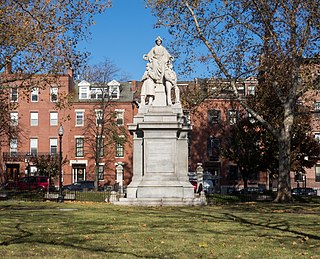
The Charlestown Civil War Memorial, also known as the Soldiers' and Sailors' Monument, is an outdoor granite monument and sculpture by Martin Milmore, commemorating the men of Charlestown, Boston, who fought to preserve the Union during the American Civil War. The memorial is installed in the Training Field in Charlestown, in the U.S. state of Massachusetts.

A statue of American Revolutionary War hero William Prescott by William Wetmore Story is installed next to the Bunker Hill Monument in Charlestown, Boston, Massachusetts, United States.
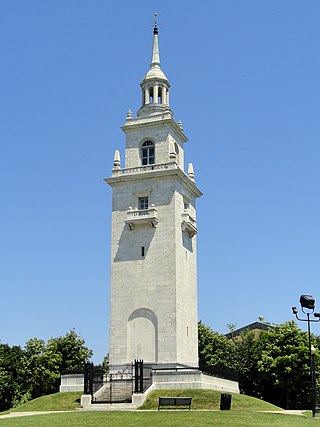
The Dorchester Heights Monument is a large public monument in the Dorchester Heights area of Boston, Massachusetts, United States. The monument, consisting of a 115-foot (35 m) marble tower, honors the evacuation of Boston during the American Revolutionary War, an early American victory in the conflict. The monument is located near where George Washington ordered the construction of a redoubt, an area which has since been developed as a public park. It was designed by the architectural firm of Peabody & Stearns and was dedicated on March 17, 1902.


















